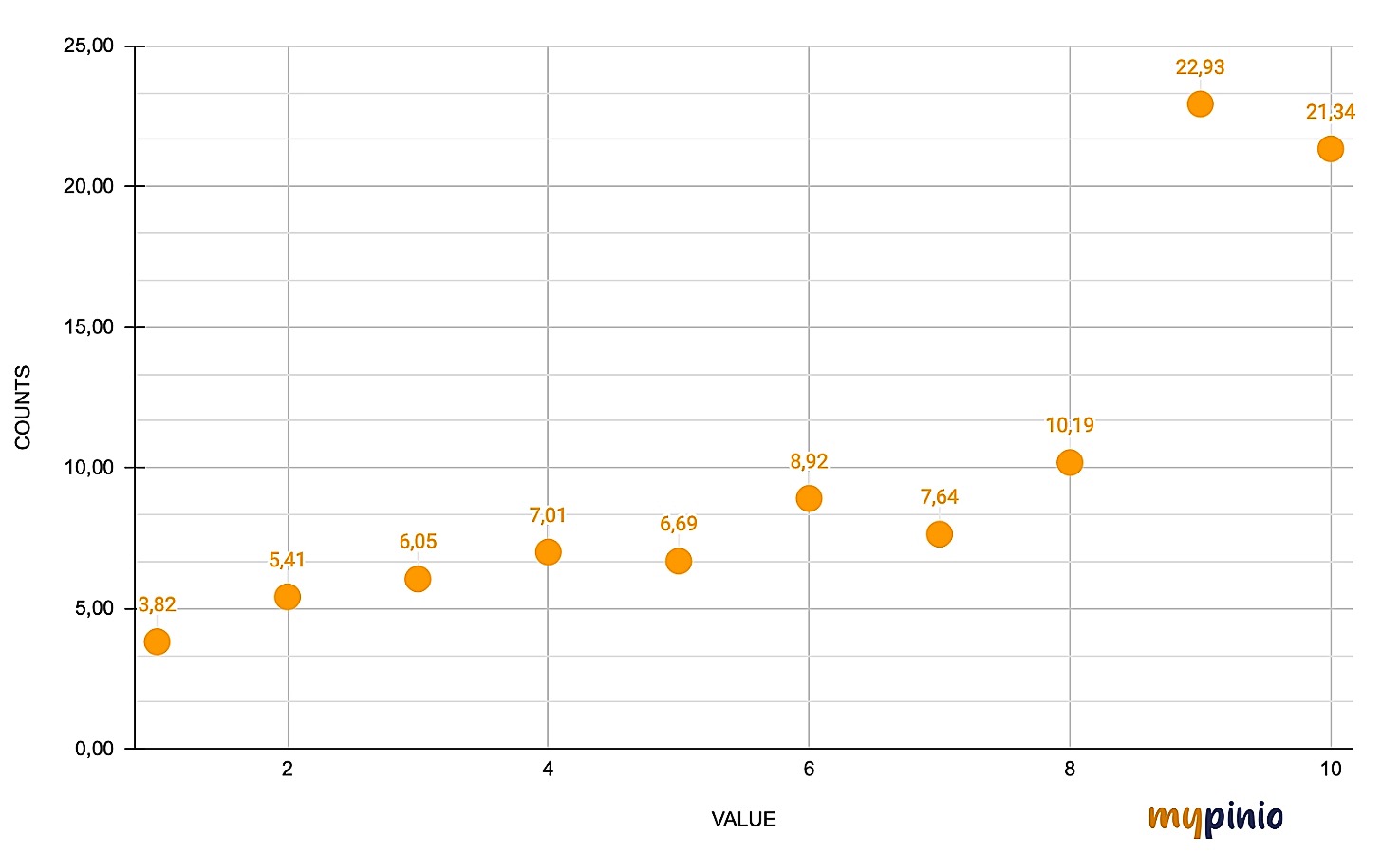 https://www.mypinio.com/wp-content/uploads/2023/02/How-to-find-promo-codes-easily.jpg
788
1400
mypinio
https://mypinio.com/wp-content/uploads/2022/04/mypinio_logo-1.png
mypinio2023-02-13 12:03:402023-02-13 12:06:15Promo Code: This is how easy you can find them to save money
https://www.mypinio.com/wp-content/uploads/2023/02/How-to-find-promo-codes-easily.jpg
788
1400
mypinio
https://mypinio.com/wp-content/uploads/2022/04/mypinio_logo-1.png
mypinio2023-02-13 12:03:402023-02-13 12:06:15Promo Code: This is how easy you can find them to save moneyCONTENT
- 1 What is the Net Promoter Score (NPS)? A definition.
- 2 Calculation of the Net Promoter Score with example
- 3 Measure and improve NPS. 5 tips to improve the Net Promoter Score
- 4 Criticisms, advantages & disadvantages of using the Net Promoter Score
- 5 Exkurs: Employee Net Promoter Score
- 6 Conclusion: Is the Net Promoter Score a useful measurement tool?
What is the Net Promoter Score (NPS)? A definition.
The Net Promoter Score (NPS) is a measurement method that measures customer loyalty and the likelihood of recommendations for a product or service. The NPS is based on a single question:
“How likely are you to recommend our company to friends and close acquaintances?”
However, the NPS question does not have to be exclusively about the company, but can also relate to brands and products. Then the NPS question would look something like this:
“How likely are you to recommend this product to friends and close acquaintances?”
Responses to this question are usually scored on a scale of 1 to 10 and divided into three categories: Advocates (Promoters), Passives and Detractors (Detractors). The answer 1 means “very unlikely” and 10 “very likely”. Promoters are those who answer the NPS question with a score of 9 or 10, passives are those who answer with a score of 7 or 8 and detractors are those who answer with a score of 6 or less. The Net Promoter Score is calculated by subtracting the number of promoters from the number of detractors. We will go into these terms and the calculation in more detail later in this expert article.
Who created the Net Promoter Score?
The Net Promoter Score was first introduced by US business strategist Frederick F. Reichheld, a partner in the management consultancy Bain & Company, in an article in the Harvard Business Review in 2003. Bain & Company developed the Net Promoter Score together with the company Satmetrix Systems (now NICE Satmetrix). Since then, the NPS has become a widely used metric by companies in many industries to measure customer satisfaction and the likelihood of referrals. A high NPS score is an indicator of strong customer loyalty and a high likelihood of referrals.
What theory is the Net Promoter Score based on?
In his book, The Ultimate Question, the developer of the NPS, Frederick F. Reichheld, argued that answering this one simple question about the likelihood of recommending a company to others is an effective way to measure customer loyalty and that complex market research studies are therefore unnecessary. The Net Promoter Score (NPS) is based on the theory that the probability that a customer recommends a company to others is a strong indicator of customer loyalty and long-term value creation. After all, anyone who makes a recommendation also reveals something about themselves. And no one would recommend something to a close person unless there is a firm conviction behind it. The idea behind the NPS question is that those customers who would definitely recommend a company or a product are the most loyal and satisfied customers. Therefore, it is assumed that the number of customers who recommend a company to others is a good indicator of overall satisfaction and customer loyalty.
Example and presentation of the NPS question
As mentioned above, the result of the Net Promoter Score is based on a single question, namely the willingness of the customer to recommend the company, the product, the brand or the service. In the simplest case, it is presented within a questionnaire or an online questionnaire as follows:
On a scale of 1-10: Would you recommend our products to good friends, relatives or close acquaintances? (1 = very unlikely; 10 = very likely)
| 1 | 2 | 3 | 4 | 5 | 6 | 7 | 8 | 9 | 10 |
| X |

However, there are also other forms of representation, such as graphic representations in the form of emojis. It is also possible to display the Net Promoter Score question with a scale of 0-10.
Calculation of the Net Promoter Score with example
In order to calculate the NPS score, the answers to the NPS question must first be divided into three categories. These categories are promoters, passives and detractors. Promoters are customers who would definitely recommend the company or its products to others. Detractors, on the other hand, are customers who would definitely not recommend the company and its products and would even post negative reviews. Passive customers are those who would neither recommend the company or its products nor publish negative reviews. In detail, the 3 categories of customers can be explained as follows.
Excursus: Promoters, passives, detractors. What exactly are these in the context of NPS?
Promoters
In the context of the Net Promoter Score (NPS), promoters are customers who would definitely recommend the company or its products to others. They usually give a score of 9 or 10 on the scale of 1 to 10 when asked how likely they would be to recommend the company or its products. Promoters are therefore very satisfied customers who rate the company and its offerings positively and would recommend it to others. They are usually loyal to the company and likely to be loyal customers. Promoters can also be seen as a driver for “word of mouth marketing” and are a valuable resource for companies to attract new customers.

Satisfied customers are worth their weight in gold for every company, because they promote brands and products through positive reviews on rating platforms and in social networks.
Passive
Passives are customers who fall into the category in the context of NPS who would neither recommend the company or its products nor post negative reviews. They typically give a rating of 7 or 8 on the scale of 1 to 10 when confronted with the NPS question of how likely they would be to recommend the company or its products. Passive customers are neither particularly satisfied nor dissatisfied with the company and its offerings. They are neutral and can therefore also be described as “undecided” or “indifferent”. They are less likely than promoters to recommend the company or its products to others and are also less loyal than promoters. Companies should focus on improving the satisfaction of passives to turn them into promoters.
Detractors
Detractors in the context of the Net Promoter Score are customers who would definitely not recommend the company or its products to others and would even post negative reviews on social media or review portals. Detractors usually give a score of 6 or less on the scale of 1 to 10 on the NPS question when asked how likely they would be to recommend the company or its products. They may also be labelled ‘critical’ or ‘dissatisfied’ and can help damage the company’s image as they may post negative reviews or complaints. Companies should focus on identifying detractors and addressing the issues that have contributed to detractors’ dissatisfaction in order to improve their satisfaction and loyalty and minimise the risk of negative impacts on the company’s image.
What formula is used to calculate the Net Promoter Score?
The Net Promoter Score (NPS) is calculated by subtracting the number of promoters (customers who give a rating of 9 or 10) from the number of detractors (customers who give a rating of 1 to 6). This value is then divided by the total number of respondents to get a percentage.
The formula for calculating NPS is:
NPS = (number of promoters / total number of respondents) – (number of detractors / total number of respondents).
Note that passives (customers who give a rating of 7 or 8) are not included in the calculation of NPS.
The NPS can take a value between -100 and 100, with an NPS value of 0 considered neutral. NPS values above 0 indicate positive customer loyalty, while NPS values below 0 indicate negative customer loyalty.
We have created the following table for you to make the calculation of the Net Promoter Score more descriptive.
Let’s assume 314 customers participated in a survey on the Net Promoter Score and the answers are distributed as follows:
| VALUE | COUNT | PERCENT | TYPE | CALC |
| 1 | 12 | 3,82 |
DETRACTORS
|
37,90
|
| 2 | 17 | 5,41 | ||
| 3 | 19 | 6,05 | ||
| 4 | 22 | 7,01 | ||
| 5 | 21 | 6,69 | ||
| 6 | 28 | 8,92 | ||
| 7 | 24 | 7,64 |
PASSIVES
|
17,83 |
| 8 | 32 | 10,19 | ||
| 9 | 72 | 22,93 |
PROMOTER
|
44,27
|
| 10 | 67 | 21,34 | ||
| TOTAL | 314 | 100,00 | NPS | 6,37 |
If we now count the number of ratings given in the red area, we arrive at the value 119. Now we have to calculate how much 119 gives in % of the total number of respondents, namely 314. This is 37.9% rounded up.
Now we have to add up the number of ratings that are found in the green zone, and that is 139. 139 is 44.27% rounded up from 314, which is the total number of respondents.
Now we have to subtract the number of detractors from the number of promoters, and this gives the Net Promoter Score (NPS value) of 6.37. So the company has a positive Net Promoter Score.
The NPS formula is therefore as follows:
NPS = (139 / 314 x 100) – (119 / 314 x 100) = 44.27% – 37.90% = 6.37%.

This scatter plot shows the distribution of responses from the sample NPS question. Here it is already clear that there are more satisfied than dissatisfied customers.

The NPS Meter shows the result of the NPS survey. The NPS meter is a popular method for displaying the result of the Net Promoter Score
Measure and improve NPS. 5 tips to improve the Net Promoter Score
The Net Promoter Score is an important indicator of the loyalty and satisfaction of a company’s customers. Therefore, it is important to measure the NPS regularly. However, measuring regularly does not mean that the NPS data is collected every 30 days or once a year. Measuring regularly means that the NPS question should ideally be asked after every interaction with customers.
Determine Net Promoter Score transactionally
An example: A customer has problems with a technical household appliance and calls the customer service of a company. Following the support call, the customer is sent an email with the NPS question. Two weeks later, the customer orders a spare part for the household appliance via the online shop. With the order confirmation, the customer receives the NPS question again by e-mail.
In the case of answering the NPS question, the company has NPS values from two different areas, namely from support and sales. This type of NPS data collection is called transactional or interaction-based NPS. The advantage of this type of NPS data collection is that the company has an independent NPS value for each point of interaction with its customers and can thus identify weaknesses more easily and quickly.
It is also important that the email with the NPS question is not only sent when support staff believe they have satisfactorily solved the customer problem, as this distorts the Net Promoter Score. The email with the NPS question should be sent automatically, for example triggered by a ticket system. To avoid annoying customers with the NPS question, you can set a ticket system to send the email with the NPS question in a random mode.
Empower your staff to handle enquiries in a satisfactory and friendly manner
Your staff should have in-depth product knowledge so that they can respond to enquiries competently and find solutions quickly. But that is not all! A friendly and relaxed attitude towards customers is also of great importance.
Employee training can help to make employees aware of how important a high level of customer satisfaction is for the success of the company. In addition, certain behavioural rules and processes can be taught that promote customer friendliness and satisfaction. An example could be showing employees how to respond appropriately to customer needs and the importance of cordial and conducive communication. Training can also help staff better respond to and act on customer feedback to improve customer experience and satisfaction.
Actively involve your customers in what is happening in the company.
Actively involving customers in the further development of products or services can help customers feel that their opinions and needs are taken seriously. This often leads to higher customer satisfaction and a higher Net Promoter Score. When customers have the opportunity to be directly involved in the development of products or services, they feel valued. In addition, products are developed closer and more closely to customers’ needs in this way, which means that they are also more likely to identify with the products. This can lead to a stronger bond with the company and higher customer loyalty, which can have a positive impact on the NPS. Such involvement can take the form of a customer insights community or customer community, for example.

The more positive customer experiences your customers have at touch and interaction points and the more personalised the customer experience, the more satisfied your customers will be and the better the Net Promoter Score will be.
Review customer experiences along the customer journey
Ensure that all interaction points with your customers are smooth, trouble-free and enjoyable. These interaction points are called touchpoints, and the sum of all touchpoints is called the customer journey. So touchpoints are interaction points where customers come into contact with a company and have a customer experience, such as when they make a phone call, visit the company’s website, send an email or visit a shop. A reviewed touchpoint process can help ensure that customers have better, positive experiences at all of these touchpoints, which in turn increases satisfaction and loyalty towards the company as a whole. This can then also have a positive impact on the Net Promoter Score, as higher customer satisfaction also means a higher likelihood that a customer will recommend the company to others.
Personalise customer experiences
Personalised approaches can improve the customer experience by creating a sense that the company values and understands the customer as an individual. This can help build a closer relationship with customers and strengthen their loyalty. A personalised approach can, for example, consist of the company using the customer’s name in marketing emails, presenting personalised offers on the website, or targeting communications to the customer’s preferences and needs. These measures can help the customer feel valued and appreciated, which in turn increases their satisfaction and trust in the company. This in turn improves customer satisfaction and can accordingly have a positive impact on the Net Promoter Score, as satisfied customers are more likely to recommend the company or its products, brands and services.
Criticisms, advantages & disadvantages of using the Net Promoter Score
One of the main advantages of the Net Promoter Score is the simplicity with which it can be used to measure satisfaction, loyalty and willingness to recommend. The NPS question is easy to understand and simple to answer. But precisely because of its simplicity, there are also critical voices that say that the NPS is not necessarily a meaningful indicator of business success. Moreover, there is also the possibility that respondents simply do not know how to answer the question or that they are not sure what is meant by “recommend”. And since there is only one question in the Net Promoter Score, this can lead to result bias.
But let’s look at some key benefits of using the Net Promoter Score:
Advantages of NPS
- Simplicity: The NPS is easy to understand and use. It is based on a single question that is easy to interpret and analyse.
- Validity: The NPS has been proven in numerous studies to be a valid indicator of customer loyalty and long-term value creation.
- Focus: The NPS can be used to set priorities for customer retention and improving the customer experience. This is because the Net Promoter Score is usually collected on an interaction basis, for example after a purchase, after a contract has been concluded, after a complaint or other contact between the company and its customers. Thus, individual NPS values are available for different areas of the company.
- Employee motivation: The Net Promoter Score can help to increase the motivation of employees, as they see that they have a direct influence on customer loyalty. For example, if the Net Promoter Score is collected following a solved support case or complaint and the NPS has a positive value, employees realise how important their work is to the company as a whole.
- Comparability: The NPS allows companies to benchmark their performance against industry peers or competitors. Similarly, the Net Promoter Score enables comparison of profit centres or departments within the company.
- Identifying change: The Net Promoter Score can be used to track and evaluate changes in customer feedback over time.
- Data-based: The NPS is based on concrete data and not just guesses or assumptions, which strengthens the decisions the company will make.
- Cost-efficiency: The Net Promoter Score can be conducted cost-efficiently as it is based on a single question and therefore requires less time and resources than more extensive customer surveys.
- Customer focus: The NPS forces companies to consider their customer perspective and focus on their needs and wants.
- Prioritisation of improvements: The Net Promoter Score can help prioritise improvements within the company. By identifying the areas where they have the most detractors, companies can focus on improving these areas to increase customer satisfaction and increase the likelihood that customers will recommend the company to others.
Disadvantages of NPS
- One-sidedness: The NPS is only based on one question and one scale, which can limit the collection of feedback.
- Lack of depth: The NPS does not provide information on why customers make a particular judgement and it can therefore be difficult to take concrete steps to improve the customer experience based on the NPS.
- No absolute measurements: The Net Promoter Score does not give absolute measurements, only comparative values. So you can’t tell if a particular NPS score is good or bad unless you compare it to other companies or industries.
- Cannot cover all aspects: The Net Promoter Score only refers to the likelihood of recommendation and not to other important aspects of the customer experience, such as product quality, price, service, etc.
- Insufficient representativeness: The NPS is based on a sample of customers and therefore cannot be considered representative of the entire customer base.
- Lack of reliability: The Net Promoter Score can be influenced by factors that have nothing to do with actual customer satisfaction, such as poor survey design or implementation. The respondents’ current mood when answering this one question can also lead to distortions.
- Unclear correlations: There are no clear correlations between NPS scores and actual business outcomes, such as sales growth or customer retention.
Exkurs: Employee Net Promoter Score
The Net Promoter Score can not only be used to determine customer loyalty and satisfaction. Companies also use the NPS to measure employee loyalty. The calculation is exactly the same. The only difference is that customers are not asked whether they would recommend a company to others, but their own employees. And the Net Promoter Score is given the prefix “Employee” when used in the context of Employee Experience Management, i.e. Employee Net Promoter Score (eNPS; ENPS; enps). The question here is: “Would you recommend our company as an employer to your friends?”.
The idea behind the eNPS is that satisfied and engaged employees have a positive influence on customer satisfaction and loyalty. The more satisfied employees are, the more satisfied a company’s customers are, because satisfied employees think and act in a more customer-oriented way and this radiates positively to the customers.
In the context of employer branding, the Employee Net Promoter Score can serve as an important indicator of the strength and attractiveness of an employer brand. A high eNPS score shows that employees are satisfied and engaged and would recommend the company. This can be interpreted as a positive signal for potential applicants and customers and contribute to an improved employer brand. A low eNPS score, on the other hand, may indicate that improvements in employee satisfaction and engagement are needed to build a strong employer brand.

Satisfied employees also have a positive impact on customer satisfaction. Therefore, it is important to regularly monitor the Employee Net Promoter Score and take action to improve where the eNPS is low, especially where employees have close contact with customers.
Conclusion: Is the Net Promoter Score a useful measurement tool?
The Net Promoter Score is a useful indicator for determining customer loyalty and satisfaction. However, the NPS should not stand alone, but should always be collected in context. By collecting the NPS at different touchpoints between companies and customers, companies can learn in more detail in which areas satisfaction is highest and where improvements are needed. Overall, touchpoint analysis combined with NPS can provide a more comprehensive understanding of the customer experience and help companies better tailor their offerings to the needs and expectations of customers.
In addition, it is useful to ask customers a follow-up question after the NPS assessment, such as why they responded to the NPS question with a particular rating. This gives companies the additional opportunity to find out deeper motivations. These follow-up questions can also consist of open-ended questions, as free-text answers can nowadays be analysed very easily using semantic text analysis, thus providing companies with a context for the customer’s rating.
However, companies should be aware that the Net Promoter Score does not cover all aspects of the customer experience and that it does not necessarily provide a complete picture of customer loyalty. It is important to consider the Net Promoter Score as part of a broader and holistic customer survey strategy that also incorporates other measurement tools and data sources to gain a more complete understanding of customer needs and expectations.
read also
#likertscale #maxdiff #semanticdifferential #marketresearch #marketresearchjobs #customercommunity #insightscommunity
[shariff]
Keywords of this blog post
Net Promoter Score | Calculation | Formula | Example | Advantages | Disadvantages | Criticism




